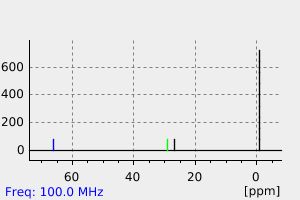三甲基甲硅烷基-2-羟基丙烷 | 121386-65-0
中文名称
三甲基甲硅烷基-2-羟基丙烷
中文别名
——
英文名称
trimethylsilyl-2-hydroxypropane
英文别名
1-(trimethylsilyl)-1-propanol;1-(trimethylsilyl)-2-propanol;me3Si(pr-2-OH);1-trimethylsilanyl-propan-2-ol;Trimethyl-(2-hydroxy-propyl)-silan;1-Trimethylsilyl-propan-2-ol;2-Propanol, 1-(trimethylsilyl)-;1-trimethylsilylpropan-2-ol
CAS
121386-65-0;145428-84-8;145428-85-9
化学式
C6H16OSi
mdl
——
分子量
132.278
InChiKey
XAQCRBIXUXIJHB-UHFFFAOYSA-N
BEILSTEIN
——
EINECS
——
-
物化性质
-
计算性质
-
ADMET
-
安全信息
-
SDS
-
制备方法与用途
-
上下游信息
-
文献信息
-
表征谱图
-
同类化合物
-
相关功能分类
-
相关结构分类
物化性质
-
沸点:48 °C(Press: 10 Torr)
-
密度:0.820±0.06 g/cm3(Predicted)
计算性质
-
辛醇/水分配系数(LogP):1.71
-
重原子数:8
-
可旋转键数:2
-
环数:0.0
-
sp3杂化的碳原子比例:1.0
-
拓扑面积:20.2
-
氢给体数:1
-
氢受体数:1
SDS
反应信息
-
作为反应物:描述:三甲基甲硅烷基-2-羟基丙烷 在 palladium on activated charcoal N-甲基吗啉 、 N-甲基吡咯烷酮 、 4-二甲氨基吡啶 、 水 、 氢气 、 N,N'-二环己基碳二亚胺 作用下, 以 二氯甲烷 、 水 、 乙酸乙酯 为溶剂, 20.0~30.0 ℃ 、100.0 kPa 条件下, 生成 H-Trp-Pro-OTmsi参考文献:名称:Application of substituted 2-(trimethylsilyl)ethyl esters to suppress diketopiperazine formation摘要:The use of differently substituted 2-(trimethylsilyl)ethyl esters for C-terminal protection in peptide synthesis has been investigated. While the use of the unsubstituted 2-(trimethylsilyl)ethyl ester resulted in a substantial amount of diketopiperazine at the dipeptide stage, use of the corresponding methyl-substituted silyl ester gave a significant reduction of this undesired pathway. Both esters could be deprotected by fluoride-induced cleavage under mild conditions. (C) 2004 Elsevier Ltd. All rights reserved.DOI:10.1016/j.tetlet.2004.03.054
-
作为产物:描述:参考文献:名称:将β-甲硅烷基酮重排为O-甲硅烷基取代的烯醇摘要:报道了将β-甲硅烷基酮重排为O-甲硅烷基取代的烯醇的条件。讨论了酮-烯醇体系中有机硅O-和C-衍生物的不可逆异构化机理。DOI:10.1016/0022-328x(68)80019-1
文献信息
-
The asymmetric hydroboration of simple alkenylsilanes: chiral α-silylalkyl- boranes and alcohols作者:John A. Soderquist、Shwn-Ji Hwang LeeDOI:10.1016/s0040-4020(01)86654-0日期:1988.1The detailed study of the asymmetric hydroboration of various vinyl-silanes with monoisopinocampheylborane ( IPCBH2) is presented. In all cases, β-substitution on the vinylsilane gives monomeric dialkylborane adducts with the boryl group α to the silicon. These studies show that the larger the groups on silicon are, the more positive the influence on the enantioselectivity of the process. Moderate
-
The oxymercuration—demercuration of alkenylsilanes in aqueous tetrahydrofuran作者:John A. Soderquist、Kerry L. ThompsonDOI:10.1016/s0022-328x(00)93802-6日期:1978.10The oxymercuration—demercuration (OM—DM) of representative trimethylsilylalkenes in aqueous tetrahydrofuran was investigated. Vinyltrimethylsilane gives only the anti-Markovnikov alcohol, 2-trimethylsilylethanol in 90% yield. Allyltrimethylsilane gives mainly allylmercuric acetate which reacts further to give a 1,3-dimercurated-2-propanol. This species reacts slowly with allyltrimethylsilane to give研究了代表性的三甲基甲硅烷基烯烃在四氢呋喃水溶液中的氧化汞-脱汞(OM-DM)。乙烯基三甲基硅烷仅以90%的产率提供抗马氏化学醇,2-三甲基甲硅烷基乙醇。烯丙基三甲基硅烷主要得到乙酸烯丙汞,其进一步反应得到1,3-二聚2-丙醇。该物质与烯丙基三甲基硅烷缓慢反应,生成烯丙基乙酸汞。3-丁烯-1-基三甲基硅烷仅以99%的产率得到马氏化学产物,即1-三甲基甲硅烷基-3-丁醇。顺式-1-丙烯基-三甲基硅烷与裂解产物一起以44%的产率得到1-三甲基甲硅烷基-2-丙醇。PMR发现其中一种产物2-丙醇的形成源自顺式OM-DM乙酸-1-丙烯基乙酸汞,得到1,1-二聚2-丙醇。同时的oxymercuration顺-1-丙烯基-乙酸汞被区域特异性赋予汞α的独家放置到硅,它是完全nonstereospecific给出非对映体加成物的等量。2-丙烯基三甲基硅烷(XIX)的OM-DM仅导致去甲硅烷基化和氧化产物。讨
-
Deoxymetalation reactions.the mechanisms of deoxysilylation of mono-trimethylsilyl-and bis-trimethylsilyl-substituted alcohols and a comparison to the mechanism of deoxystannylation and deoxyplumbylation作者:Dennis D. Davis、Henry M. JacocksDOI:10.1016/s0022-328x(00)93462-4日期:1981.2trimethylsilyl group, and a mechanism involving a hyper- conjugatively-stabilized carbocation intermediate is proposed. In contrast, the deoxymetalation reactions of the triphenyltin-, triphenyllead-, and iodomercury-analogs exhibits very different structure-reactivity relationships and have been described as proceeding through concerted E2-like or bridge-ion mechanisms. These mechanistic regimes are2-三甲基甲硅烷基-1-羟基乙烷,4、1-三甲基甲硅烷基-2-羟基丙烷,5、1,3-双(三甲基甲硅烷基)-2-羟基丙烷,6和1-三甲基甲硅烷基-2的酸催化脱氧甲硅烷基化的相对速率在40℃下在9体积%的甲醇水溶液中,发现7的-甲基-2-羟基丙烷分别为1:10 3.30:10 5.92:10 6.77。这些比率与携带核试剂的碳上的取代基的δ +常数的总和成正比(ϱ += − 11)。两个三甲基甲硅烷基的加合速率的加速作用要求每个三甲基甲硅烷基具有相同的共轭稳定作用,并提出了一种涉及超共轭稳定的碳正离子中间体的机理。相反,三苯基锡,三苯基铅和碘汞类似物的脱氧金属化反应显示出非常不同的结构反应性关系,并被描述为通过协同的E 2进行。类或桥离子机制。通过考虑桑顿反应键规则,考虑了有机金属离去基团的共轭相互作用,电逸性和亲核溶剂辅助,可以协调这些机制。该分析表明存在一系列的合并机制,酸催化的脱氧甲硅烷基化代表一个极端,E
-
Gmelin Handbuch der Anorganischen Chemie, Gmelin Handbook: Si: MVol.C, 9, page 28 - 32作者:DOI:——日期:——
-
FISSION OF BETA-OXYGENATED ORGANOSILICON COMPOUNDS作者:F. C. Whitmore、L. H. Sommer、Jack Gold、R. E. Van StrienDOI:10.1021/ja01198a525日期:1947.6
表征谱图
-
氢谱1HNMR
-
质谱MS
-
碳谱13CNMR
-
红外IR
-
拉曼Raman
-
峰位数据
-
峰位匹配
-
表征信息
同类化合物
(反式)-4-壬烯醛
(s)-2,3-二羟基丙酸甲酯
([1-(甲氧基甲基)-1H-1,2,4-三唑-5-基](苯基)甲酮)
(Z)-4-辛烯醛
(S)-氨基甲酸酯β-D-O-葡糖醛酸
(S)-3-(((2,2-二氟-1-羟基-7-(甲基磺酰基)-2,3-二氢-1H-茚满-4-基)氧基)-5-氟苄腈
(R)-氨基甲酸酯β-D-O-葡糖醛酸
(5,5-二甲基-2-(哌啶-2-基)环己烷-1,3-二酮)
(2,5-二氟苯基)-4-哌啶基-甲酮
龙胆苦苷
龙胆二糖甲乙酮氰醇(P)
龙胆二糖丙酮氰醇(P)
龙胆三糖
龙涎酮
齐罗硅酮
齐留通beta-D-葡糖苷酸
鼠李糖
黑芥子苷单钾盐
黑海棉酸钠盐
黑木金合欢素
黑曲霉三糖
黑介子苷
黄尿酸8-O-葡糖苷
麻西那霉素II
麦迪霉素
麦芽糖脎
麦芽糖基海藻糖
麦芽糖1-磷酸酯
麦芽糖
麦芽四糖醇
麦芽四糖
麦芽十糖
麦芽六糖
麦芽五糖水合物
麦芽五糖
麦芽五糖
麦芽五糖
麦芽三糖醇
麦芽三糖
麦芽三糖
麦芽三塘水合
麦芽七糖水合物
麦芽七糖
麦法朵
麦可酚酸-酰基-Β-D-葡糖苷酸
麦利查咪
麝香酮
鹤草酚
鸢尾酚酮 3-C-beta-D-吡喃葡萄糖苷
鸡矢藤苷







